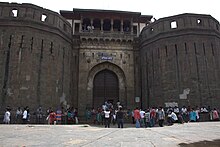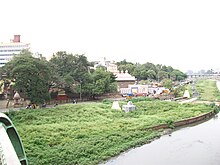
Pune, previously spelled in English as Poona, is a city in Maharashtra state in the Deccan plateau in Western India. It is the administrative headquarters of the Pune district, and of Pune division. According to the 2011 Census of India, Pune is the ninth-most populous city in India with a population of 3.1 million residents within the city limits, and 7.2 million residents in the metropolitan region, making it the eight-most populous metropolitan area in India. The city of Pune is part of Pune Metropolitan Region. Pune is one of the largest IT hubs in India. It is also one of the most important automobile and manufacturing hubs of India. Pune is often referred to as "Oxford of the East" because of its highly regarded educational institutions. It has been ranked "the most liveable city in India" several times.

Bajirao I, born as Visaji, was the 7th Peshwa of the Maratha Confederacy.

Peshwa was second highest office in the Maratha Confederacy, next in rank and prestige only to that of the Chhatrapati. Initially serving as the appointed prime minister in the Maratha empire, the office became hereditary after the death of Shahu in 1749. During the reign of Shahu, the office of Peshwa grew in power and the Peshwas came to be the de facto rulers of the Maratha empire. However following the defeat of the Marathas in 1761, the office of the Peshwa became titular as well and from that point onwards served as the ceremonial head of the Confederacy underneath the Chhatrapati.

Shaniwar Wada is a historical fortification in the city of Pune, India.

Madhavrao I was the 9th Peshwa of the Maratha Confederacy. During his tenure, the Maratha Confederacy recovered from the losses they suffered during the Third Battle of Panipat, an event known as Maratha Resurrection.

Mastani was the daughter of Chhatrasal and Ruhani Bai Begum. She was the second wife of the Maratha Peshwa Baji Rao I. Her relationship within the Maratha Brahmin family has been subject of both admiration and controversy and well adapted in Indian novels and cinema.
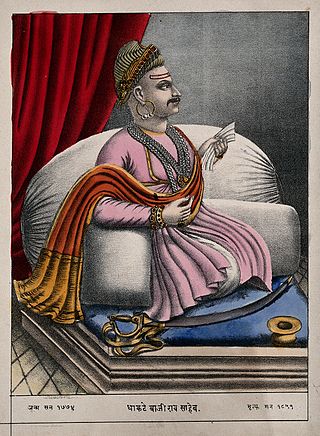
Baji Rao II was the 13th and the last Peshwa of the Maratha Confederacy. He governed from 1795 to 1818. He was installed as a puppet ruler by the Maratha nobles, whose growing power prompted him to flee his capital Poona and sign the Treaty of Bassein (1802) with the British. This resulted in the Second Anglo-Maratha War (1803–1805), in which the British emerged victorious and re-installed him as the titular Peshwa. In 1817, Baji Rao II joined the Third Anglo-Maratha War against the British, after they favoured the Gaekwad nobles in a revenue-sharing dispute. After suffering several battle defeats, the Peshwa surrendered to the British, and agreed to retire in return for an estate at Bithoor and an annual pension.
Wai is a town in Satara district of Maharashtra state in India. Located on the Krishna River, Wai was a prominent town during the Peshwa era. Two important Marathi Brahmin from ruling families had their origins here: Rani Lakshmibai of Jhansi and Gopikabai, wife of Nanasaheb Peshwa.

Pune district is a district in Western Maharashtra with Administrative Headquarters in Pune city. Pune district is the most populous district in the Indian state of Maharashtra. It is one of the most industrialised districts in India.
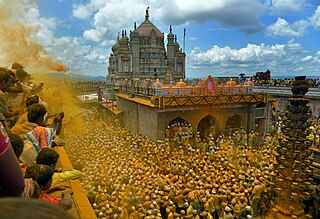
Jejuri is a city and a municipal council in the Pune district of Maharashtra, India. Khandoba Mandir is an important Hindu temple to the Hindu Lord Khandoba, one of the most visited tirtha in Maharashtra.
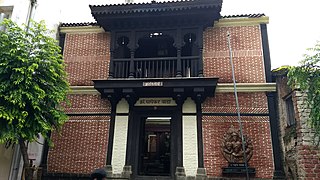
Chinchwad is an upscale locality in the city of Pimpri Chinchwad, which is about 15 km (9.3 mi) northwest of the historic city of Pune situated on the banks of Pavna river. The neighborhood is home to extensive industry and is well known for its automotive, pharmaceutical, electrical products, electronics and hardware, aerospace and manufacturing units.
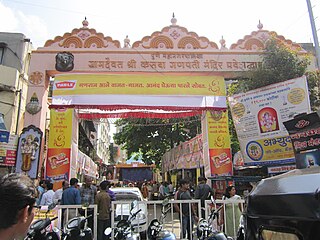
Kasba Peth or Kasba is the oldest residential part, "Peth " (locality), in Pune, India. It is adjacent to the historic Shaniwar Wada palace-fort. Kasba Peth was the first Peth to be established sometime during the 5th century, and is the oldest area in Pune. It is called the "Heart of Pune City". In the history of Pune, the city was once known as "Kasbe Pune".
Pune is the 9th most populous city in India and one of the largest in the state of Maharashtra.
Menavli is a village about three kilometres from Wai in the Satara district. The village's claim to fame is due to the palace (wada) built by Nana Fadnavis, 18th century Maratha statesman and the regent of Peshwa Madhavrao II.

Shivajinagar is an inner suburb of the city of Pune, India. Shivajinagar is known as Heart of the City.
Saswad is a municipal council located on South-Eastern corridor of Pune district of the Indian state of Maharashtra. Saswad is situated on the banks of the Karha River. Saswad is about 31 km from Pune-Central Station.

Vishrambaag Wada, a fine mansion situated at central Pune's Thorale Bajirao Road, was the luxurious residence of Peshwa Baji Rao II, the last Peshwa of Maratha confederacy, in early 19th century. The 20,000 sq.ft. wada presently houses a post office on its ground floor, a few other offices of the municipal corporation and a small museum of Maratha artifacts put together by noted Maratha historian, Babasaheb Purandare. This structure is famous for its fine entrance and the balcony with carved woodwork.

Shri Laxmi Narsimha Temple is a Hindu temple dedicated to Narasimha, an avatar of Vishnu, located in western India, in Pune district of the state of Maharashtra. The temple is located at the confluence of Bhima river and Nira river, at the south eastern tip of Pune district, in Indapur taluka.

Chandrashekhar Govind Agashe was an Indian industrialist and lawyer, best remembered as the founder of the Brihan Maharashtra Sugar Syndicate Ltd. He served as the managing agent of the company from its inception in 1934 till his death in 1956. He served as the President of the Bhor State Council from 1934 to 1948, having previously been the council's Vice President from 1933 to 1934, its Secretary from 1932 to 1933, and the Chief Justiciar of the Indian princely state itself from 1920 to 1932.
